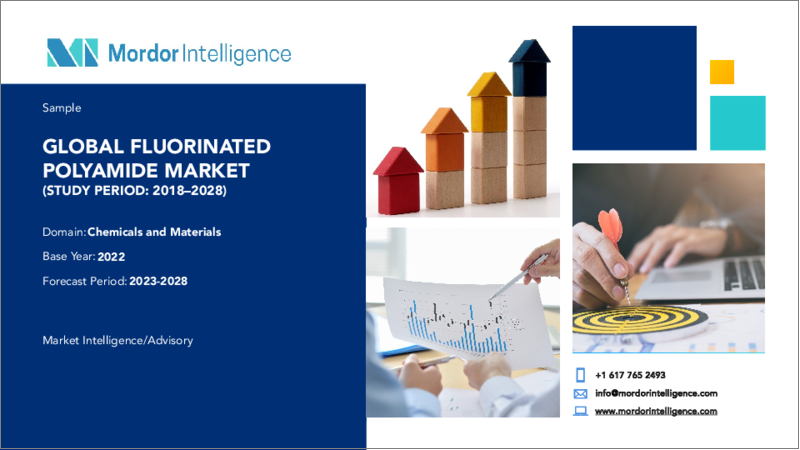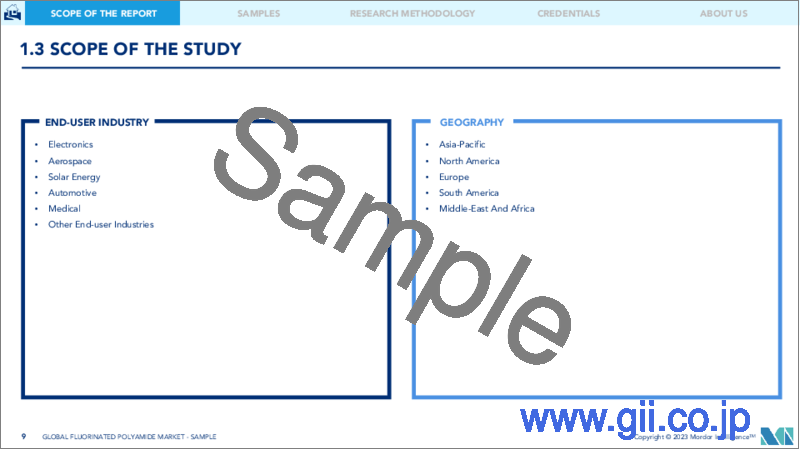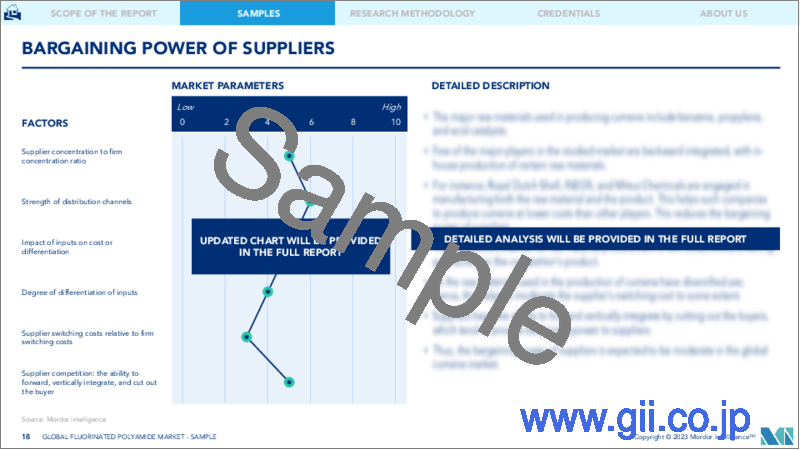|
|
市場調査レポート
商品コード
1190903
フッ素化ポリイミド市場- 成長、動向、予測(2023年-2028年)Fluorinated Polyimide Market - Growth, Trends, and Forecasts (2023 - 2028) |
||||||
|
● お客様のご希望に応じて、既存データの加工や未掲載情報(例:国別セグメント)の追加などの対応が可能です。 詳細はお問い合わせください。 |
|||||||
| フッ素化ポリイミド市場- 成長、動向、予測(2023年-2028年) |
|
出版日: 2023年01月18日
発行: Mordor Intelligence
ページ情報: 英文 120 Pages
納期: 2~3営業日
|
- 全表示
- 概要
- 目次
フッ素化ポリイミドの世界市場は、予測期間(2022-2027年)に70%以上のCAGRで推移すると予測されています。
2020年にCOVID-19が発生し、市場に悪影響。2020年前半のCOVID-19の発生により、エレクトロニクスおよびオプトエレクトロニクス産業は大きな影響を受けました。フッ素化ポリイミドの主要メーカーは東南アジア諸国に集中していることから、これらの地域でCOVID-19の流行が長引いたことで、エレクトロニクス製品群の製造・販売が大幅に減速したのです。このため、フッ素系ポリイミドの消費率は悪化しました。しかし、2021年半ば以降、パンデミックは収束に向かい、フッ素化ポリイミド市場はエレクトロニクス分野への新たな関心を背景に堅調に推移すると予想されます。
主なハイライト
- 短期的には、先進国および新興国での新しい高度な電子機器に対する需要の高まりが、市場の成長を押し上げる主な要因の1つとなっています。
- しかし、正確な製品化学と均一性を得るための複雑さと、原材料の入手の不確実性が相まって、一般的に投入コストが高くなり、予測期間中の対象産業の成長に対する大きな抑制要因となっています。
- しかしながら、宇宙探査や航空事業の拡大、医療分野への政府投資の増加や拡張は、高い絶縁性と低誘電率特性を持つフッ素化ポリイミドに有利な市場成長機会をもたらす可能性があります。さらに、燃料電池の分離膜としてのフッ素化ポリイミドの新たな用途が、需要のファンダメンタルズをより高い水準に押し上げると期待されています。
- アジア太平洋地域は市場を独占し、予測期間中に最も高いCAGRで推移すると予想されます。この成長は、この地域でフッ素化ポリイミドの生産と消費が最も多いことに起因しています。主要メーカーは日本に集中しており、日本はフッ素化ポリイミドの世界生産において90%以上のシェアを占め、世界をリードしています。中国、日本、インドなどの国々で急成長しているエレクトロニクス、自動車、医療分野は、アジア太平洋地域におけるフッ素化ポリイミドの消費拡大に寄与しています。
主な市場動向
フレキシブルディスプレイ材料用途でのフッ素化ポリイミドの需要増加
- 2021年のフッ素化ポリイミド市場では、フレキシブルディスプレイ材料用途のセグメントが大きな収益シェアを占めています。
- フッ素化ポリイミドは、疎水性の増加によって誘発される低吸湿性により、大幅に低下した誘電率を示します。さらに、これらのポリイミドは、低屈折率、近赤外および可視領域での強化された透明性、熱分解温度の上昇、高い耐久性などを持っています。これらの特性から、ディスプレイスクリーンへの応用が期待されています。また、フッ素化ポリイミドの薄膜は、密着性、摩擦係数が低く、タッチスクリーン機器のタッチ抵抗の低減に寄与しています。スマートフォンやLEDテレビなど、日常的に使用される製品の需要が急増したことで、市場のダイナミクスは強気で推移しています。壊れやすく柔軟性に欠けるガラスや不透明な金属箔の使用から、現在一般的な薄型フレキシブルスクリーンへの移行は、フッ素化ポリイミド市場のファンダメンタルズを強化しました。フレキシブルなアクティブマトリクス型有機発光ダイオード(AMOLED)ディスプレイの進歩により、サムスンやLGなどの多くのスマートフォン開発会社が、最近、フレキシブルディスプレイのスマートフォン開発に乗り出しています。
- フレキシブルディスプレイの用途拡大や、各電子機器エンドユーザーにおけるフッ素化ポリイミドの採用拡大が、対象産業の成長を促す主な要因の一つとなっています。例えば、次のようなことです。
- 中国国家統計局が発表した統計によると、中国の電子機器製造業の付加価値の年間成長率は、2020年の7.7%に対し、2021年は15.7%を占めました。
- 消費者技術協会によると、米国の家電産業の成長率は、2020年に登録された-2.2%の成長率に対して、2021年には4.3%と登録され、それによってフッ素化ポリイミドの需要を高め、調査した市場の成長を強化しました。
- 2022年5月、サムスンは最近特許を取得したスライド式ラップアラウンドフレキシブルディスプレイを搭載したスマートフォンを発売する計画を発表しました。
- 2021年5月には、Appleが8インチのフレキシブル有機ELディスプレイを搭載した折りたたみ式iPhoneを2023年に発売する計画を発表し、折りたたみ式スマートフォンの流行に乗ることが確認されました。
- したがって、前述の要因を考慮すると、フッ素化ポリイミドの需要は、近い将来、フレキシブルディスプレイ材料および関連電子機器のエンドユーザーセグメントで大幅に上昇することが予想されます。
アジア太平洋地域が市場を独占
- アジア太平洋地域は、2021年に収益面で大きな市場シェアを獲得して世界市場を独占し、2022-2027年の予測期間中もその支配を維持すると予測されます。アジア諸国におけるエレクトロニクスおよび自動車産業でのフッ素化ポリイミドに対する需要の高まりが、アジア太平洋地域の対象産業の成長を促進する主な要因となっています。中国やインドなどの国々では、ライフスタイルの向上や可処分所得の増加により、家電製品や先端技術自動車の需要が高まっています。中国はエレクトロニクスと家電産業の中心地であり、次いで日本が、これらの国から多くのブランドを生み出しています。また、中国は需要・供給の両面で最大の自動車産業の地位を誇っています。
- フッ素化ポリイミドは、前述のエンドユーザー産業以外にも、航空宇宙、医療、太陽エネルギーの分野でも使用されています。フッ素化ポリイミドの優れた熱的・機械的特性は、航空宇宙産業において絶縁体や電気スペーサーの形で利用されています。最近では、NASAが航空宇宙の熱制御コーティングとして使用される一連の無色ポリイミドフィルムを開発したこともその一つです。
- 中国、インド、日本では自動車とエレクトロニクス部門が急速に成長しており、フッ素ポリイミドの需要を促進しているため、この市場の成長はさらに高まると考えられます。
- OICAによると、中国は2021年に2608万台の自動車を生産し、2020年の2523万台と比較して3%の増加を記録し、この動向が予測期間におけるフッ素ポリイミドの需要に対する前向きな見通しを刺激しています。
- さらに、インド・ブランド・エクイティ財団によると、インドの電子機器の国内生産は2014-15年の290億米ドルから2020-21年には670億米ドルに拡大し、電子機器分野のそれぞれの用途でフッ素化ポリイミドの需要を後押ししているとのことです。
- グラスゴーで開催されたCOP26気候会議でインドが行った公約によると、2030年までに非化石エネルギー容量500GWの達成を目標としています。そのためには、太陽光発電のインフラを大規模に整備する必要があり、フッ素系ポリイミドの高い需要が見込まれます。
- 日本は、住友化学、ダイキン工業、三菱ガス化学、カネカなどの主要メーカーを抱え、世界市場を席巻しています。輸入依存度を減らすために、Kolon Industries、SKC、SK Innovationなどの韓国企業もフッ素化ポリイミド製品の生産工場の拡張に向けて努力を重ねています。
- 前述のすべての要因が、予測期間中にアジア太平洋地域のフッ素化ポリイミド市場の成長を促進する可能性があります。
競合情勢
フッ素化ポリイミド市場は、統合的な性格を有しています。市場の主なプレーヤーには、住友化学、ダイキン工業、デュポン、Kolon Industries、SKCなどが含まれます(順不同)。
その他の特典
- エクセル形式の市場予測(ME)シート
- アナリストによる3ヶ月間のサポート
目次
第1章 イントロダクション
- 調査の前提条件
- 調査範囲
第2章 調査手法
第3章 エグゼクティブサマリー
第4章 市場力学
- 促進要因
- フレキシブルディスプレイの消費者需要の高まり
- その他の促進要因
- 抑制要因
- 複雑な合成に伴う高い投入コストと、原材料の入手の不確実性
- その他の阻害要因
- 産業バリューチェーン分析
- ポーターのファイブフォース分析
- 供給企業の交渉力
- 買い手の交渉力
- 新規参入業者の脅威
- 代替品の脅威
- 競合の度合い
第5章 市場セグメンテーション
- 用途
- フレキシブルディスプレイ材料
- 電気絶縁材料
- 構造用樹脂
- 太陽電池
- ライティングデバイス
- その他の用途
- エンドユーザー産業
- エレクトロニクス
- 航空宇宙
- ソーラーエネルギー
- 自動車
- 医療
- その他エンドユーザー産業
- 地域別
- アジア太平洋地域
- 中国
- インド
- 日本
- 韓国
- その他アジア太平洋地域
- 北米
- 米国
- カナダ
- メキシコ
- 欧州
- ドイツ
- 英国
- イタリア
- フランス
- その他欧州
- 南米
- ブラジル
- アルゼンチン
- その他の南米地域
- 中東・アフリカ
- サウジアラビア
- 南アフリカ
- その他中東地域
- アジア太平洋地域
第6章 競合情勢
- M&A、ジョイントベンチャー、共同研究、合意形成
- 市場シェア(%)**/ランキング分析
- リーディングプレーヤーが採用した戦略
- 企業プロファイル
- Capchem
- Daikin Industries, Ltd.
- DuPont
- I.S.T Corporation
- Kaneka Corporation
- Kolon Industries
- Mitsubishi Gas Chemical Company, Inc.
- Nexolve
- SK Innovation Co. Ltd.
- SKC
- Sumitomo Chemical Co., Ltd.
第7章 市場機会と将来動向
- 燃料電池におけるフッ素化ポリイミドの新たな応用分野
- 世界のヘルスケア・インフラの継続的な発展
- 宇宙探査の活発化
The Global Fluorinated Polyimide Market is projected to register a CAGR of over 70% during the forecast period (2022-2027).
The market was negatively impacted by COVID-19 in 2020. Due to the COVID-19 outbreak in the first half of 2020, the electronics and optoelectronics industry was significantly affected. Given that the key manufacturers of fluorinated polyimide are concentrated in the Southeast Asian countries, the prolonged prevalence of the COVID-19 pandemic in these areas drastically slowed down the manufacturing and sale of the electronics product line. This, in turn, had deteriorated the rate of consumption of fluorinated polyimide. Nevertheless, with the ongoing retraction of the pandemic since mid-2021, the fluorinated polyimide market is projected to grow steadily owing to the renewed interest of customers in electronics.
Key Highlights
- Over the short term, the growing demand for new and advanced electronic devices in the developed and emerging economies worldwide is one of the key driving factors augmenting the growth of the market studied.
- However, the complexity to get the precise product chemistry and uniformity, coupled with uncertainty in raw material availability typically results in high input costs which is a major restraining factor for the growth of the target industry over the forecast period.
- Nevertheless, the growing space exploration and aviation activities as well as the growing government investments and expansion in the medical sector are soon likely to create lucrative market growth opportunities for fluorinated polyimide attributed to their high insulation and low dielectric constant properties. Furthermore, the emerging applications for fluorinated polyimide as separating membranes in the upcoming fuel cell technologies are expected to drive up the demand fundamentals to a higher level.
- The Asia-Pacific region is expected to dominate the market and is also likely to witness the highest CAGR during the forecast period. This growth is attributed to the highest production and consumption of fluorinated polyimide in this region. With key manufacturers concentrated in Japan, the country leads the world with a lion's share of over 90% in the global production of fluorinated polyimide. The fast-growing electronics, automotive, and medical sectors in the countries including China, Japan, and India, contribute to the rising consumption of fluorinated polyimide in the Asia-Pacific region.
Key Market Trends
Rising Demand for Fluorinated Polyimide in Flexible Display Materials Application
- The Flexible Display Materials application segment accounted for a significant revenue share in the fluorinated polyimide market in 2021.
- Fluorinated polyimides exhibit substantially reduced dielectric constant due to low moisture absorption induced by the increase in hydrophobicity. Furthermore, these polyimides have low refractive indices, enhanced transparency in the NIR and visible regions, increased thermal decomposition temperature, high durability, etc. These properties make them suitable candidates for use in display screens. Thin films of fluorinated polyimides show a reduced degree of adhesiveness and friction coefficient which aids in lowering the touch resistance in touchscreen devices. The sharp rise in everyday usage and demand for smartphones and LED TVs has stimulated the market dynamics on the bullish trend. The transition from the use of fragile, less-flexible glass and opaque metal foils to the now common thin flexible screens has fortified the fluorinated polyimide market fundamentals. The advances in flexible active-matrix organic light-emitting diode (AMOLED) displays have caused many smartphone developers like Samsung and LG to foray into the development of flexible display smartphones lately.
- Augmenting flexible display device applications and rising adoption of fluorinated polyimide in respective electronics end-user segment, are among the key factors driving the growth of the target industry. For instance,
- According to the stats released by the National Bureau of Statistics of China, the annual growth rate of value added in the electronics manufacturing industry in China accounted for 15.7% in 2021, compared to 7.7% in 2020.
- As per the Consumer Technology Association, the growth rate of the consumer electronics industry in United States was registered at 4.3% in 2021, in comparison to -2.2% growth rate registered in the year 2020, thereby enhancing the demand for fluorinated polyimide and strengthening the growth of the market studied.
- In May 2022, Samsung announced its plan to launch its recently patented smartphone having a slidable wraparound flexible display.
- In May 2021, Apple confirmed jumping on the foldable smartphones bandwagon with its plans to launch a foldable iPhone having an 8-inch flexible OLED display in 2023.
- Therefore, considering the aforementioned factors, the demand for fluorinated polyimide is expected to rise in the flexible display materials and related electronics end-user segment significantly in near future.
Asia-Pacific Region to Dominate the Market
- The Asia-Pacific region dominated the worldwide market in 2021, with a significant market share in terms of revenue, and is projected to maintain its dominance during the forecast period of 2022-2027. Growing demand for fluorinated polyimide in the electronics and automotive industries across the Asian countries is a primary factor driving the growth of the target industry in the Asia-Pacific. The improving lifestyle and growing disposable income in countries like China and India have fueled the demand for consumer electronics and advanced technology vehicles. China is the hub for electronics and home appliances industries, followed by Japan with many brands originating from these countries. China also boasts the title of the largest automotive industry in terms of both demand and supply.
- Besides the aforementioned end-user industries, fluorinated polyimide finds applications in the aerospace, medical, and solar energy sectors. The excellent thermal and mechanical features of fluorinated polyimide are exploited in the aerospace industry in the form of insulators and electrical spacers. One of the recent advances includes NASA developing a series of colorless polyimide films used as thermal-control coatings in aerospace.
- The rapidly growing automotive and electronics sector in China, India, and Japan are propelling demand for fluorine polyimide which will further enhance the growth of the market studied.
- According to OICA, China produced 26.08 million unit's vehicles in 2021, registering an increase of 3% compared to 25.23 million units produced in 2020, a trend stimulating a positive outlook for demand for fluorinated polyimide in the forecast period.
- Moreover, as per India Brand Equity Foundation, the domestic production of electronics in India has grown from USD 29 billion in 2014-15 to USD 67 billion in 2020-21, which has propelled the demand for fluorinated polyimide in respective applications in the electronics segment.
- As per the commitments made by India at the COP26 Climate Conference held in Glasgow, the country is targeting to achieve 500 GW of non-fossil energy capacity by 2030. The initiative will require installations of solar energy-derived power generation infrastructure on a large scale, thereby creating a high demand for fluorinated polyimide.
- Japan holds key manufacturers like Sumitomo Chemical Co., Ltd., Daikin Industries, Mitsubishi Gas Chemical Company, Inc., Kaneka Corporation, thus having domination in the global market share. To decrease dependence on imports, South Korean companies like Kolon Industries, SKC, SK Innovation, Co. Ltd. have also stridden up their efforts towards the expansion of fluorinated polyimide product production plants.
- All aforementioned factors are likely to fuel the growth of the Asia-Pacific fluorinated polyimide market over the forecast time frame.
Competitive Landscape
The fluorinated polyimide market is consolidated in nature. Some of the major players in the market include Sumitomo Chemical Co., Ltd., Daikin Industries, Ltd., DuPont, Kolon Industries, and SKC among others (not in any particular order).
Additional Benefits:
- The market estimate (ME) sheet in Excel format
- 3 months of analyst support
TABLE OF CONTENTS
1 INTRODUCTION
- 1.1 Study Assumptions
- 1.2 Scope of the Study
2 RESEARCH METHODOLOGY
3 EXECUTIVE SUMMARY
4 MARKET DYNAMICS
- 4.1 Drivers
- 4.1.1 Surge in Consumer Demand for Flexible Display Devices
- 4.1.2 Other Drivers
- 4.2 Restraints
- 4.2.1 High Input Costs Associated with Complex Synthesis and Uncertainty in Raw Material Availability
- 4.2.2 Other Restraints
- 4.3 Industry Value-Chain Analysis
- 4.4 Porter's Five Forces Analysis
- 4.4.1 Bargaining Power of Suppliers
- 4.4.2 Bargaining Power of Buyers
- 4.4.3 Threat of New Entrants
- 4.4.4 Threat of Substitute Products and Services
- 4.4.5 Degree of Competition
5 MARKET SEGMENTATION
- 5.1 Application
- 5.1.1 Flexible Display Materials
- 5.1.2 Electrical Insulation
- 5.1.3 Structural Resins
- 5.1.4 Solar Cells
- 5.1.5 Lighting Devices
- 5.1.6 Other Applications
- 5.2 End-user Industry
- 5.2.1 Electronics
- 5.2.2 Aerospace
- 5.2.3 Solar Energy
- 5.2.4 Automotive
- 5.2.5 Medical
- 5.2.6 Other End-user Industries
- 5.3 Geography
- 5.3.1 Asia-Pacific
- 5.3.1.1 China
- 5.3.1.2 India
- 5.3.1.3 Japan
- 5.3.1.4 South Korea
- 5.3.1.5 Rest of Asia-Pacific
- 5.3.2 North America
- 5.3.2.1 United States
- 5.3.2.2 Canada
- 5.3.2.3 Mexico
- 5.3.3 Europe
- 5.3.3.1 Germany
- 5.3.3.2 United Kingdom
- 5.3.3.3 Italy
- 5.3.3.4 France
- 5.3.3.5 Rest of Europe
- 5.3.4 South America
- 5.3.4.1 Brazil
- 5.3.4.2 Argentina
- 5.3.4.3 Rest of South America
- 5.3.5 Middle East and Africa
- 5.3.5.1 Saudi Arabia
- 5.3.5.2 South Africa
- 5.3.5.3 Rest of Middle East and Africa
- 5.3.1 Asia-Pacific
6 COMPETITIVE LANDSCAPE
- 6.1 Mergers and Acquisitions, Joint Ventures, Collaborations, and Agreements
- 6.2 Market Share (%) **/Ranking Analysis
- 6.3 Strategies Adopted by Leading Players
- 6.4 Company Profiles
- 6.4.1 Capchem
- 6.4.2 Daikin Industries, Ltd.
- 6.4.3 DuPont
- 6.4.4 I.S.T Corporation
- 6.4.5 Kaneka Corporation
- 6.4.6 Kolon Industries
- 6.4.7 Mitsubishi Gas Chemical Company, Inc.
- 6.4.8 Nexolve
- 6.4.9 SK Innovation Co. Ltd.
- 6.4.10 SKC
- 6.4.11 Sumitomo Chemical Co., Ltd.
7 MARKET OPPORTUNITIES AND FUTURE TRENDS
- 7.1 Emerging Applications of Fluorinated Polyimide in Fuel Cell Applications
- 7.2 Continuing Advancements in Global Healthcare Infrastructure
- 7.3 Growing Space Exploration Activities




